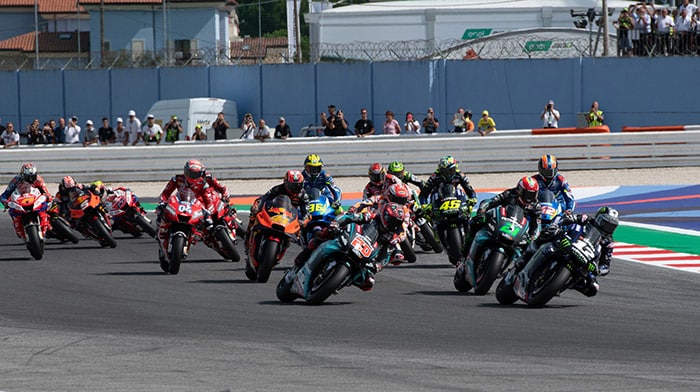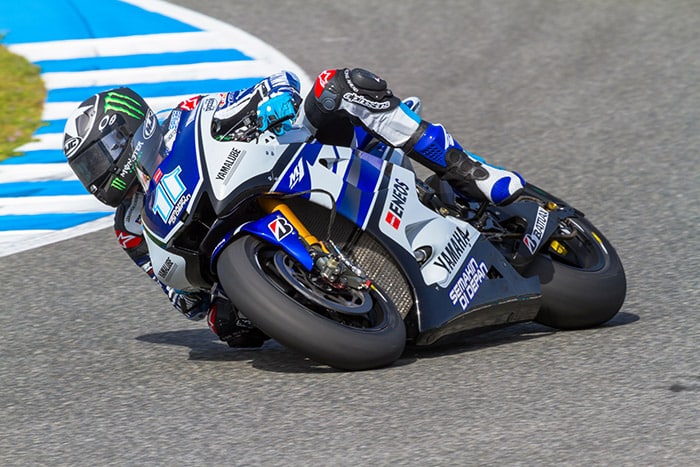The MotoGP Championship is the premier class of motorcycle road racing and a favorite amongst many motorsport fans.
Despite not being the biggest, the bikes used in MotoGP feature some of the latest advancements in technology.
As you watch your favorite MotoGP rider speeding down the racetrack, you may be curious about the cc of MotoGP bikes.
The MotoGP class is powered by a 1,000cc engine with a maximum of four cylinders that produce up to 240 horsepower with a top speed of 225 mph (362km/h).
We cover everything you need to know about the engines used in MotoGP over the years and the current engine capacity requirements.
History of the MotoGP Bikes Engine

Originally known as the 500cc class before becoming ‘MotoGP’ in 2002, the Grand Prix Motorcycle Racing was established in 1949 by the FIM (Fédération Internationale de Motocyclisme).
It is the oldest Motorsport World Championship today.
Traditionally, each event featured multiple races with different classes of motorcycles based on engine size and one type for sidecars.
The first few years saw races in 50cc, 80cc, 125cc, 250cc, 350cc, 500cc and 750cc solo bikes and 350cc and 500cc sidecars – which were phased out from world championship events in the 1990s.
Four-stroke were the predominant engines used across all classes from the 1950s through most of the 1960s.
In the 1960s, advances in engine design and technology allowed 2-stroke engines to begin gaining a foothold in the smaller class.
From the mid-70s to 2001, the top GP racing class allowed a maximum 500cc displacement with four cylinders, regardless of whether it was a 2-stroke or 4-stroke engine.
In 2002, the premier class was rebranded ‘MotoGP’, and 500cc 2-stroke bikes were quickly phased out.
Manufacturers had a choice between running 2-stroke engines up to 500cc or 4-strokes up to 990cc.
The new 4-stroke engine quickly came to dominate the 2-stroke competitors, and as a result, no 2-stroke bikes remained in the MotoGP field, although the 125cc (Moto3) and 250cc (Moto2) classes were still made up entirely of 2-stroke machines.
In 2007, MotoGP’s maximum displacement capacity was reduced to 800cc and remained there until 2012.
After five years with 800cc bikes, the MotoGP engine capacity increased to 1,000cc and has remained the same since.
What Engines are Used in MotoGP?
MotoGP riders use prototypes made from the highest quality materials with a maximum engine displacement capacity of 1,000cc.
The engines used in MotoGP are far more advanced than average production bikes, developed with the latest and most up-to-date technology.
A MotoGP bike has four cylinders and a maximum bore of 81 mm, producing up to 240 horsepower with a top speed of 225 mph (362km/h).
The minimum weight limit of MotoGP bikes is 346 lbs (157 kg) – if a bike weighs less than this, a team may be disqualified for breaking a technical regulation.
Moreover, all engines must be normally aspirated (no turbocharging or supercharging).
The engines used in MotoGP are from the following manufacturers:
- Aprilia
- Ducati
- Honda
- KTM
- Suzuki
- Yamaha
In MotoGP, we see engine configurations like an inline 4 and V4 cylinder configuration.
Constructors may use either configuration, but in most cases, the V4 configuration is preferred as it offers more power.
For the 2023 season, only Yamaha Factory Racing will stick to its inline four-cylinder concept, while other manufacturers in the championship will use a V4 configuration.
Classes of MotoGP

There are currently three classes within the sport, including the eponymous MotoGP, Moto2 and Moto3 – four if you count MotoE.
Moto2
Moto2 is a class of motorcycle racing in which the maximum displacement is 765cc and three cylinders.
In 2010, Moto2 used 600cc Honda engines before changing to 765cc Triumph engines, which are still used today.
All bikes are required to use a Triumph 765cc engine that produces 140 horsepower.
Because all riders use the same engine, how the race plays out depends on the skills of the rider and the suspension rather than the engine.
The minimum combined weight of the bike and rider cannot be less than 595 lbs (270 kg).
Moto3
Moto3 is another class of racing in which engines are restricted to single-cylinder 250cc four-stroke engines with a maximum bore of 81 mm.
Prior to 2012, Moto3 was the 125cc class of 2-stroke engines, making these bikes considerably smaller in terms of engine capacity than the other two streams of GP motorcycle racing.
Today, all Moto3 bikes use 250cc 4-stroke engines with a bore of 81 mm, and the combined weight rule of the bike and rider cannot be less than 326 lbs (138 kg).
Moto3 allows teams to use any engine from any manufacturer, making the race more competitive and cheaper for teams to enter.
MotoGP FAQs
What cc do Moto2 and Moto3 bikes use?
Moto2 bikes use a 765cc three-cylinder engine that produces 140 horsepower, while Moto3 bikes use a 250cc four-stroke engine that produces 60 horsepower.
Are MotoGP engines available to the public?
The MotoGP engine is a prototype and cannot be purchased or used by the general public.
Since these bikes are designed for extreme performance on the track, no law enforcement agency in the world would allow them on their roads.
Conclusion
Once known as the 500cc class, today, the MotoGP class features powerful 1,000cc engines with a maximum of four cylinders that produce up to 240 horsepower with a top speed of 225mph (362km/h).
Made from the highest quality materials and the latest advancements in technology, MotoGP bikes are not for the faint-hearted.
These powerful engines are designed for the fastest riders in the world.
